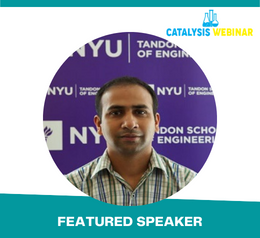Scholars International Webinar on
Catalysis, Chemical Engineering & Technology
THEME: "Contemporary Advances and Innovations in Catalysis and Chemical Engineering Research"
 25-26 Nov 2021
25-26 Nov 2021  Online | Virtual
Online | Virtual THEME: "Contemporary Advances and Innovations in Catalysis and Chemical Engineering Research"
 25-26 Nov 2021
25-26 Nov 2021  Online | Virtual
Online | Virtual 
New York University, USA
Title: 2D Transition Metal Dichalcogenide Nanosheets with Single Atom Dopants as Efficient Catalysts for Hydrotreating
Ayaskanta Sahu is an Assistant Professor in the Department of Chemical and Biomolecular Engineering at the New York University Tandon School of Engineering. His research focuses broadly on how to develop artificial materials that do not exist in nature; how to derive novel properties from existing materials by tuning their size (nanostructuring) and adding trace amounts of intentional impurities (doping); and finally how to incorporate these materials into functional devices that can harness new forms of energy or improve the efficiency of existing energy conversion devices. Prior to joining NYU, he was a Materials Postdoctoral Fellow at the Molecular Foundry, Lawrence Berkeley National Laboratory in Berkeley, California. He holds a B. Tech. degree in Chemical Engineering from the Indian Institute of Technology Roorkee and a Ph.D. in Chemical Engineering from the University of Minnesota. He spent a couple of years at ETH Zurich as a visiting scientist before joining LBNL.
Tailoring
highly efficient catalysts is of utmost importance to reduce the carbon and
energy footprints of industrial processes. An important class of industrial
chemistries is hydrotreating whereby heteroatoms such as sulfur, oxygen, and
nitrogen in carbon-containing feedstocks (hydrocarbons and biomass) are removed
catalytically using molecular hydrogen. Transition metal dichalcogenides, such
as molybdenum sulfide (MoS2), have been employed in bulk form commercially
as hydrodesulfurization catalysts due to their widespread availability. In the nanoscale,
MoS2 forms stable two-dimensional nanosheets, which exhibit impressive
catalytic activity along the nanosheet edge sites. Conversely, the non-edge
atoms of the basal plane are sufficiently coordinated and thus relatively
inert. Given that a large portion of the surface area is inactive, there is a
strong impetus towards modifying and nanostructuring 2D materials to activate
the basal plane, such as through decorating the surface with singular dopant
atoms to create isolated single-atom active sites that may possess novel
catalytic properties for hydrogenation/hydrogenolysis chemistries. Here, we
demonstrate the controlled, tunable in-situ cobalt doping of MoS2
nanosheets grown via colloidal hot-injection method. A set of catalysts with
various cobalt loadings were studied for hydrodesulfurization of thiophene and
hydrodeoxygenation, specifically probing the effects of dopant concentration
and local structure of single cobalt atoms, inferred from x-ray absorption
spectroscopy and density functional theory (DFT), on catalytic activity. We
demonstrate that the relationship between dopant concentration and thiophene
conversion is non-linear, and an optimal cobalt loading exists for these
hydrotreating reactions.